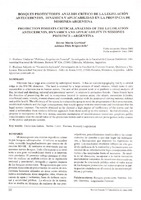Bosques protectores análisis crítico de la legislación antecedentes, dinámica y aplicabilidad en la provincia de Misiones, Argentina
Protection forests critical analysis of the legislation antecedents, dynamics and applicability in Misiones province, Argentina
Date
2003-07-01Author
Gartland, Héctor Martín
Brignardello, Adriana Élida
Metadata
Show full item recordAbstract
Misiones posee una extensa superficie cubierta por bosques subtropicales. El relieve está accidentado, recorrido longitudinalmente por sierras en dirección SO-NE. El territorio es atravesado por numerosos cursos de agua. Todo ello expone a su territorio a una gran vulnerabilidad frente a la intervención antrópica. El presente trabajo persigue el objetivo de realizar un análisis crítico de la legislación nacional y provincial 2, derogada y vigente respecto de los bosques protectores. Bosques estos que comprenden funciones de preservación de suelos de ecosistemas boscosos ubicados en áreas como taludes, laderas montañosas, áreas anegadas, islas, riberas de cursos de agua y vertientes, fines de defensa nacional y salubridad pública. La eficacia de la normativa se evalúa en términos de realismo de sus prescripciones, procedimientos establecidos y las consecuencias de derecho a que dan lugar las restricciones, y limitaciones que imponen los regímenes legales. Los resultados obtenidos reflejan un alto grado de ineficacia de la normativa y la consecuente necesidad de su reformulación bajo concepciones diferentes a las empleadas hasta el momento. Se resalta en tal dirección, incorporar a la nueva normativa instrumentos concretos de incentivos-desincentivos, propiciar la conciencia pública sobre el valor social de los bosques protectores así como auspiciar la participación ciudadana en el control de las acciones públicas y privadas. Misiones has a large area covered by subtropical forests. It has an uneven topography run by a central ridge in the SW-NE direction. The land is crossed by a large amount of small streams, which turns it very susceptible to alluvium due to human action. The aim of the present work is to perform a critical analysis of the, revoked and standing, national and provincial norms', in relation to protection forests. These forests have the function of preserving the soil in ecosystems located in various areas, like slopes, mountains hillsides, overflowed areas, islands, streams shores and watersheds, and also with the purpose of serving national defense and public health. The efficiency of the norms is evaluated keeping in mind the pragmatism of their prescriptions, established methods and the legal consequences that would appear with the restrictions and limitations that the legal system imposes. The results obtained so far showed a high degree of inefficiency of the norms and the need to reformulate them under a different approach from those used up to this moment. In that direction, we propose to incorporate in the new norms, concrete instruments of incentives-non incentives, propitiate public consciousness over the social value of the protection forests and to patronize citizen participation in the control of the public and private actions.
Collections
- Revista Yvyraretá [351]
The following license files are associated with this item:




